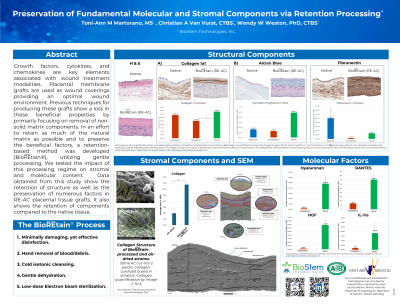Laboratory Research
(LR-028) Preservation of Fundamental Molecular and Stromal Components via Retention Processing
Friday, May 2, 2025
7:45 PM - 8:45 PM East Coast USA Time

Christian Van Vurst, CTBS – Lead Lab Technician, Biostem Technologies; Wendy Weston, PhD, CTBS – VP Research & Development, R&D, Biostem Technologies
Introduction: Growth factors, cytokines, and chemokines are key elements associated with wound treatment modalities. Placental membrane grafts are used as wound coverings providing an optimal wound environment. Previous techniques for producing these grafts show a loss in these beneficial properties by primarily focusing on removal of non-solid matrix components. In an effort to retain as much of the natural matrix as possible and to preserve the beneficial factors, a retention-based method was developed (BioREtain®), utilizing gentle processing. We tested the impact of this processing regime on stromal and molecular content.
Methods: Five separate lots of retention-processed final product tri-layer amnion/chorion grafts (RE-AC) were assessed for structural components and molecular factors. This was achieved by histology, scanning electron microscopy (SEM), and cytokine analysis by enzyme-linked immunosorbent assay (ELISA). Products were reported as amount of factor per cm2.
Results: Data obtained from this study show the retention of structure as well as the preservation of numerous factors in RE-AC placental tissue grafts. It also shows the retention of components compared to the native tissue.
Discussion: This study highlights the hypothesis that retention-based processing demonstrates conservation of structural and molecular components.
Methods: Five separate lots of retention-processed final product tri-layer amnion/chorion grafts (RE-AC) were assessed for structural components and molecular factors. This was achieved by histology, scanning electron microscopy (SEM), and cytokine analysis by enzyme-linked immunosorbent assay (ELISA). Products were reported as amount of factor per cm2.
Results: Data obtained from this study show the retention of structure as well as the preservation of numerous factors in RE-AC placental tissue grafts. It also shows the retention of components compared to the native tissue.
Discussion: This study highlights the hypothesis that retention-based processing demonstrates conservation of structural and molecular components.

.jpg)